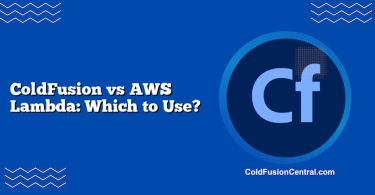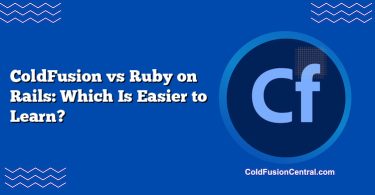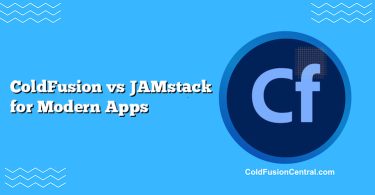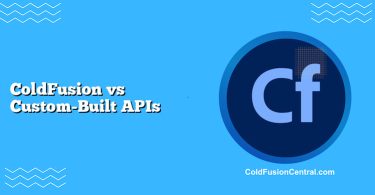Definitions
-
ColdFusion: A rapid web application development platform centered on the ColdFusion Markup Language (CFML). Implementations include Adobe ColdFusion (commercial) and Lucee (open-source). ColdFusion runs on the JVM, provides built-in services (database access, PDF generation, mail, scheduling, caching), and is commonly deployed as an application server behind a web server.
-
Edge Computing Solutions: An architectural approach and set of platforms that execute code and process data closer to users or data sources (e.g., at CDN PoPs or on IoT gateways) to reduce latency, offload origin servers, and improve resilience. Examples include Cloudflare Workers, AWS Lambda@Edge, Fastly Compute@Edge, Akamai EdgeWorkers, and Azure IoT Edge for device/gateway workloads.
Overview
ColdFusion at a glance
ColdFusion is a server-side web platform for building dynamic sites and APIs using CFML, a tag-based and scriptable language. It bundles many enterprise conveniences—ORM, caching, session management, PDF/reporting, WebSocket support, task scheduling, and REST endpoints—reducing third-party dependencies. Organizations with legacy CFML codebases or teams valuing rapid development often prefer ColdFusion, either with Adobe ColdFusion’s enterprise features or Lucee’s lightweight, open-source runtime.
Edge Computing Solutions at a glance
Edge solutions run code near users or devices. In the CDN context, edge functions intercept HTTP requests and responses to perform routing, authentication, personalization, and caching. In IoT and industrial contexts, edge runtimes process sensor data locally, act autonomously when offline, and sync with the cloud. The edge is inherently distributed, event-driven, and built for sub-millisecond or low-millisecond responses.
Comparing scope: platform vs. architecture
- ColdFusion is a specific application runtime and framework (platform + language).
- Edge computing is an architecture delivered by multiple vendors and runtimes.
They can coexist: for example, ColdFusion as the origin API and edge functions for caching, security, and personalization in front of it.
Key Features
ColdFusion key features
- CFML and CFScript support for fast, readable server-side development
- Built-in services: PDF/Office document manipulation, image processing, mail (CFMAIL), scheduled tasks, WebSocket, REST, GraphQL (via extensions)
- Database integration with CFQUERY; ORM via Hibernate
- Session and application scope management, caching, and rate limiting
- JVM-based deployment; integrates with Apache, Nginx, or IIS; container images available
- Enterprise administration and monitoring (Adobe CF Administrator, Performance Monitoring Toolset), SSO, security hardening guides
Edge computing key features
- Ultra-low-latency request handling at CDN PoPs; egress control and smart routing
- Programmable caching, A/B testing, bot mitigation, and geo-aware personalization
- Serverless at the edge: automatic scaling, minimal cold starts on advanced platforms
- Distributed KV stores, Durable Objects, and streaming transforms (e.g., Cloudflare KV/Durable Objects, Fastly Object Store)
- IoT edge runtimes for local filtering/inference, offline-first behavior, and gateway orchestration
- Observability, zero-trust access, and integrated WAF/CDN/DDoS protections
Architecture and Deployment Models
ColdFusion deployment patterns
- Single server or clustered instances behind a load balancer
- On-premises VMs or containers in Kubernetes
- Origin server model: CF app serves HTML or JSON consumed by SPAs or mobile apps
- Blue/green deployments via containers; CI/CD using Jenkins, GitHub Actions, or Azure DevOps
Edge deployment patterns
- CDN-based edge functions: code bound to routes or distributions (CloudFront, Cloudflare)
- Micro-frontends and API gateways at the edge
- IoT edge devices/gateways running containers with local modules (Azure IoT Edge, AWS IoT Greengrass)
- Fan-out/fan-in patterns: pre-compute and push logic to multiple PoPs or devices
Performance
ColdFusion performance considerations
- Strengths: JVM performance, in-memory caches, connection pooling, efficient PDF/reporting tasks, and quick CRUD/API construction
- Considerations: Global latency for distant users, potential heavy requests (report generation) increasing response times, need for horizontal scaling under bursty loads
- Tuning: Use cache headers, page/object caching, async tasks, and queueing for long-running jobs. Place CDN in front to offload static and cacheable responses.
Edge performance considerations
- Strengths: Dramatically lower latency for global users; immediate request manipulation and caching; high concurrency by default
- Considerations: Execution time, memory, and storage quotas; vendor-specific APIs; limited language/runtime features (e.g., restricted Node APIs)
- Tuning: Keep logic stateless and minimal; move heavy compute to origin or background workers; use distributed KV/Durable Objects for coordination; minimize cold starts
Scalability and Reliability
- ColdFusion: Scales by adding instances/containers. Requires session management strategy (sticky sessions or external session store), health checks, and autoscaling. Reliability depends on infrastructure, database redundancy, and caching tiers.
- Edge: Scales automatically across many PoPs or devices. Built-in resilience at the network layer; however, stateful logic must be thoughtfully designed (e.g., coordination through Durable Objects or message queues).
Security and Compliance
- ColdFusion: Mature hardening guidance, role-based admin, secure profile. Patching cadence is crucial. Integrations: LDAP, SSO/SAML, WAF in front, and database security. Supports TLS termination at web server or load balancer.
- Edge: Security benefits from zero-trust models, pre-origin request filters, bot protection, and integrated WAF/DDoS. For regulated workloads (PII, HIPAA, PCI), ensure the edge vendor’s compliance scope covers processing locations and data residency. IoT edge must secure device identity, firmware, and encrypted channels.
Cost Model
-
ColdFusion
- Adobe ColdFusion: Commercial licensing per core; includes enterprise tools and support.
- Lucee: Open-source, lower runtime cost; commercial support available via third parties.
- Infrastructure: VM/container costs, database, caching layers, observability stack, and ops time.
- Predictable for steady workloads; can be cost-effective for complex features bundled into the platform.
-
Edge Computing
- Serverless pricing: pay per request, CPU time, and data transfer. Attractive for bursty traffic and low-maintenance operations.
- CDN and egress fees apply; storing data at the edge (KV/object storage) adds cost but reduces origin hits.
- IoT edge: device fleet management and gateway hardware costs.
- Can be cheaper for global latency reduction compared to multi-region origins.
Developer Experience and Ecosystem
Community Support
- ColdFusion: Longstanding community, docs, and forums. Adobe provides enterprise support; Lucee has an active open-source community. Many legacy codebases and migration guides.
- Edge: Rapidly growing communities per vendor (Cloudflare, AWS, Fastly, Akamai). Strong examples, templates, and DevRel content. Vibrant serverless and JAMstack ecosystems.
Tooling and libraries
- ColdFusion: CFML/CFScript, built-in tags (CFQUERY, CFMAIL, CFDOCUMENT), admin UIs, and JVM tooling. Frameworks: ColdBox, FW/1, CommandBox CLI.
- Edge: TypeScript/JavaScript or Rust SDKs, Wrangler/Workers, Fastly CLI, AWS SAM/CloudFormation, Terraform modules, and observability via vendor dashboards and OpenTelemetry.
Real-World Use Cases
When ColdFusion shines
- Enterprise portals and line-of-business apps requiring heavy PDF/report generation, scheduled jobs, email workflows, and tight integration with relational databases.
- Rapid API development with CFML and ORM, where teams value productivity.
- Modernization of legacy CFML applications by containerizing Adobe CF or Lucee, adding a CDN, and incrementally refactoring.
Scenario: A financial services intranet app generates regulated PDF statements, schedules nightly batch jobs, and enforces strict access through corporate SSO. ColdFusion’s CFDOCUMENT, CFMAIL, and built-in scheduling streamline the solution without a patchwork of services.
When Edge solutions shine
- Global e-commerce or media sites needing millisecond personalization at the CDN layer (geo, device, A/B tests) and aggressive caching to reduce origin load.
- Security middleware: authenticate requests, enforce rate limits, sign URLs, and block bots before requests hit the origin.
- IoT/industrial setups: preprocess sensor data locally, run ML inference at gateways, and sync only relevant data to the cloud.
Scenario: A news publisher runs personalization (region/language), paywall checks, and split testing at the edge, cutting latency and origin costs. Long-tail content is cached, while dynamic APIs at the origin (possibly ColdFusion or another stack) are called only when necessary.
Side-by-side Comparison Table
| Dimension | ColdFusion (Adobe CF / Lucee) | Edge Computing Solutions (Workers, Lambda@Edge, IoT Edge) |
|---|---|---|
| Scope | Application server and CFML runtime | Distributed execution near users/devices; architecture + platforms |
| Performance | Strong on origin; JVM speed; benefits from caches/CDN | Ultra-low latency; auto-scale; quotas on CPU/memory/runtime |
| Scalability | Horizontal scaling via instances/containers | Implicit scaling across PoPs/devices; state management patterns needed |
| Cost | License (Adobe) or free (Lucee) + infra/ops | Pay-per-request/compute + CDN/egress; device/gateway costs for IoT |
| Use cases | Enterprise apps, PDFs, scheduled tasks, CRUD APIs | Personalization, routing, security at the edge; IoT local processing |
| Pros | Rapid development, rich built-ins, mature admin | Global speed, fewer servers, security at the perimeter, serverless |
| Cons | Origin latency for global users, ops overhead, licensing (Adobe) | Runtime limits, vendor lock-in, distributed state complexity |
| Languages | CFML/CFScript on JVM | JS/TS, Rust, Go/Wasm (varies by vendor); IoT uses containers |
| Deployment | VMs, containers, on-prem/cloud | CDN PoPs, edge networks, device gateways |
| Security | App server hardening, WAF, SSO | Zero-trust, WAF/DDoS at edge, data residency considerations |
Pros and Cons
ColdFusion: Pros
- Very fast development with CFML/CFScript and rich built-in features
- Stable JVM runtime; strong PDF/reporting and scheduled jobs
- Mature operations and monitoring; easy integration with RDBMS
- Lucee offers cost-efficient, open-source deployment
ColdFusion: Cons
- Not inherently distributed; needs CDN and scaling strategy for global performance
- Adobe licensing can be costly; patch management required
- Smaller talent pool compared to mainstream stacks
Edge Computing: Pros
- Low-latency execution near users; excellent for personalization and security
- Serverless at the edge reduces origin load and ops burden
- Integrated CDN, WAF, DDoS protection, and observability
- IoT edge enables offline-first processing and immediate insights
Edge Computing: Cons
- Vendor-specific runtimes, APIs, and constraints (CPU time, memory, storage)
- Managing distributed state and consistency can be complex
- Potential lock-in and data residency/compliance challenges
Decision Factors / Which One Should You Choose?
-
Problem scope
- Primarily building an application/API with rich server-side features? Choose ColdFusion.
- Need global low-latency routing/personalization/security or IoT local processing? Choose Edge.
-
Performance and latency targets
- If most users are in one region and latency is acceptable, ColdFusion with a CDN may suffice.
- For global audiences needing sub-50 ms TTFB, run logic at the edge.
-
Scaling and reliability
- ColdFusion: scale via containers; externalize sessions; cache aggressively.
- Edge: built-in scale, but plan for distributed state via KV/Durable Objects or queues.
-
Cost profile
- Steady workloads with complex features may be cost-effective on ColdFusion (especially Lucee).
- Spiky traffic and global distribution often cost less on pay-per-use edge platforms.
-
Compliance and data governance
- Keep sensitive processing at a controlled origin if residency rules are tight.
- If using the edge, verify vendor compliance scope and data location controls.
-
Team expertise and time-to-value
- Existing CFML skills and legacy investments favor ColdFusion.
- Teams proficient in JavaScript/TypeScript or Rust can be highly productive at the edge.
-
Hybrid approach
- Common winning pattern: ColdFusion as origin for core business logic and data, with edge functions handling caching, auth, and personalization for global speed.
Supported Platforms and Options
-
ColdFusion
- Adobe ColdFusion 2023+ (commercial), Lucee 6+ (open-source)
- Runs on JVM (Windows, Linux, macOS), integrates with Apache/Nginx/IIS
- Official Docker images; deploy on Kubernetes, AWS, Azure, GCP
- Frameworks: ColdBox, FW/1; CLI: CommandBox
-
Edge Computing
- CDN/serverless: Cloudflare Workers (KV, Durable Objects, R2, D1), AWS Lambda@Edge and CloudFront Functions, Fastly Compute@Edge, Akamai EdgeWorkers
- IoT edge: Azure IoT Edge, AWS IoT Greengrass, NVIDIA Jetson platforms
- Languages: JavaScript/TypeScript, Rust, Go, WebAssembly (varies by vendor)
-
Language syntax differences (high level)
- CFML/CFScript: Tag-based (e.g.,
, ) plus script syntax resembling ECMAScript; tight integration with JVM and JDBC. - Edge JS/TS: Fetch-style APIs (Request/Response), streaming transforms, async/await, limited Node APIs; Rust SDKs for performance-critical code on some platforms.
- CFML/CFScript: Tag-based (e.g.,
Key Takeaways / Summary Points
- ColdFusion is a full-featured application server and language; Edge computing is an architectural paradigm with multiple vendor runtimes.
- Choose ColdFusion for rapid enterprise app development, heavy server-side features (PDFs, scheduled jobs), and predictable operations.
- Choose Edge for near-user execution, global personalization, origin offload, and IoT local processing.
- A hybrid model—ColdFusion origin plus edge functions for caching, security, and routing—often delivers the best latency and cost efficiency.
- Consider compliance, state management, and team skill sets before committing to one approach, and pilot with a narrow use case to validate assumptions.
FAQ
Can I use ColdFusion and edge computing together?
Yes. A common architecture is ColdFusion as the origin API or app, fronted by a CDN with edge functions. The edge handles authentication, AB testing, and caching, while ColdFusion performs business logic and data access. This hybrid approach delivers excellent performance and developer productivity.
Which is cheaper: ColdFusion or an edge platform?
It depends on workload. Steady traffic and heavy server-side features can be cost-effective on Lucee or licensed Adobe ColdFusion if you already have infrastructure. Spiky, globally distributed traffic often costs less on serverless edge with pay-per-request pricing. Include CDN/egress and support costs in your model.
Is ColdFusion still viable for modern development?
Yes. With containers, CI/CD, and a CDN, ColdFusion remains viable, especially for teams with CFML expertise or legacy apps. Lucee is popular for open-source, lightweight deployments. For greenfield projects, evaluate ecosystem fit and hiring availability alongside technical needs.
What are common pitfalls when moving logic to the edge?
Underestimating runtime limits, ignoring data consistency, and coupling to vendor-specific APIs. Keep edge logic stateless where possible, use distributed stores for coordination, and isolate provider-specific code behind interfaces to reduce lock-in.
How do I decide between CDN edge functions and IoT edge runtimes?
They serve different needs. CDN edge functions optimize and secure HTTP traffic near users. IoT edge runtimes run on gateways/devices to process sensor data locally and work offline. Some organizations use both: IoT edge for industrial telemetry and CDN edge for web application acceleration.




